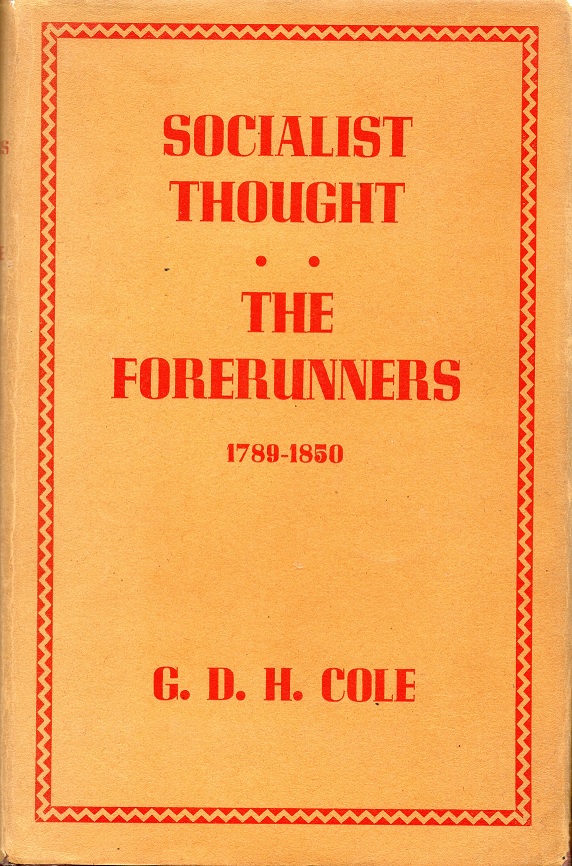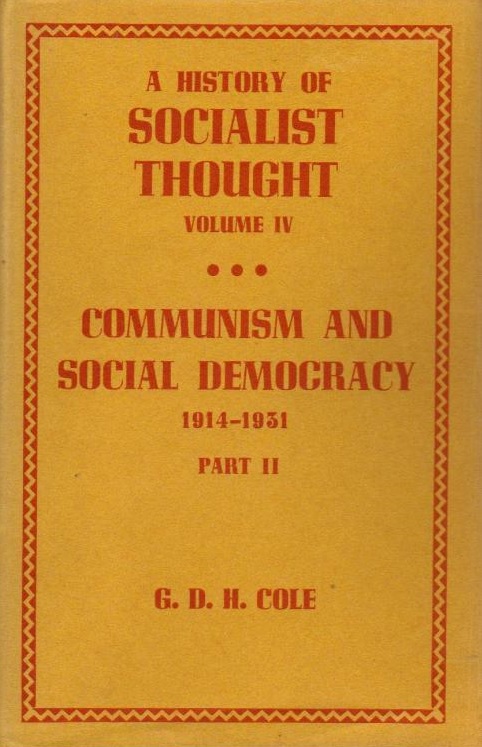Biblioteca / 1950-1959 1960-1969
George D. H. Cole. History of Socialist Thought.
Londres: Macmillan, 1953/1960.
Volumen 1: The Forerunners, 1789-1850. xi, 346 páginas. 1953.
Volumen 2: Marxism and Anarchism, 1850-1890. xi, 482 páginas. 1953.
Volumen 3, parte 1: The Second International, 1889-1914. xvii, 518 páginas. 1956.
Volumen 3, parte 2: The Second International, 1889-1914. viii, 519-1043 páginas. 1956.
Volumen 4, parte 1: Communism and Social Democracy, 1914-1931. x, 455 páginas. 1958.
Volumen 4, parte 2: Communism and Social Democracy, 1914-1931. viii, 457-940 páginas. 1958.
Volumen 5: Socialism and Fascism, 1931-1939. xvi, 351 páginas. 1960.
Edición en castellano, Historia del pensamiento socialista. México: FCE, 1957/1963.
CONTENTS
Volume I
The Forerunners, 1789-1850
Preface
The Principal Characters
I – Introductory
II – The Great French Revolution and the Conspiracy of Gracchus Babeuf
III – Godwin, Paine, and Charles Hall
IV – Saint-Simon
V – The Saint-Simonians
VI – Fourier and Fourierism
VII – Cabet and the Icarian Communists
VIII – Sismondi
IX – Owen and Owenism — Earlier Phases
X – Socialist Economics in the 1820s
XI – Owen and the Trade Unions — The End of Owenism
XII – John Francis Bray
XIII – The People’s Charter
XIV – Blanqui and Blanquism
XV – Louis Blanc and the Organisation of Labour
XVI – Buchez — Pecqueur
XVII – Flora Tristan
XVIII – Lamennais
XIX – Proudhon
XX – German Socialism — the Beginnings
XXI – Bruno Bauer, Hess, and Grün — The ‘True Socialists’
XXII – The Communist Manifesto
XXIII – Marx and Engels — Marxism to 1850
XXIV – Mazzini — The European Revolutions of 1848
XXV – The Christian Socialists
XXVI – A Summing Up
Select Bibliography
__________
Volume II
Marxism and Anarchism, 1850-1890
Preface
The Principal Characters
I – Introductory: Socialism after 1848
II – German Socialism in the 1850s — Rodbertus and Marlo
III – The Dawn of Socialism in Russia — Belinsky, Herzen, and Chernyshevsky
IV – Belgian Socialism in the 1850s — Colins, Kats, and De Keyser
V – Lassalle
VI – The First International in the ‘Sixties
VII – The Paris Commune
VIII – Decline and Fall of the First International
IX – Bakunin
X – German Socialism after Lassalle — ‘Christian Socialists’ and ‘State Socialists’ — The Kulturkampf and the Aanti-Socialist Laws
XI – Marx and Engels — Das Kapital and Anti-Dühring
XII – Anarchists and Anarchist-Communists — Kropotkin
XIII – American Socialism in the Second Half of the Nineteenth Century — Henry George and Daniel De Leon
XIV – The Revival of British Socialism — William Morris
XV – Socialism in the Early 1890s. Conclusion
Select Bibliography
__________
Volume III
The Second International, 1889-1914
Part I
Preface
The Principal Characters
Introduction
I – The Second International: Early Years
II – The Second International: Later Years
1900 — Paris
1904 —Amsterdam
1907 — Stuttgart
1910 — Amsterdam
1912 — Bâle
1914 —Vienna and Paris. The Collapse of the Second International
III – Great Britain — Socialism before the Labour Party
The Beginnings of Fabian Socialism.
The New Unionism and its Background
The Independent Labour Party
Robert Blatchford and The Clarion
IV – Great Britain — the Labour Party and the Great Unrest
The Rise of the Labour Party – Socialists and Liberals – H. G. Wells
Fabian Socialism — The Webbs, Shaw and Wallas
The Great Unrest – The Labour Party and its Leaders – Syndicalism and Guild Socialism
V – Germany: the Revisionist Controversy
VI – Germany after the Revisionist Controversy: Appearance and Reality
VII – France to 1905
VIII – France after 1905. The Unified Party and the Syndicalists. Jaurès and Sorel
IX – Russia to 1905
X – The First Russian Revolution
XI – Poland — Rosa Luxemburg
__________
Volume III
The Second International, 1889-1914
Part II
The Principal Characters
XII – Austria
Appendix: Theodor Hertzka
XIII – Hungary
XIV – The Balkans
General
Bulgaria
Rumania
Serbia
Greece
Turkey and Armenia
XV – Switzerland
XVI – Belgium: The Social Democratic Stalemate
XVII – Holland
XVIII – Scandinavia and Finland
Denmark
Sweden
Norway
Finland
XIX – Italy
XX – Spain
XXI – The United States – Canada
XXII – Latin America: the Mexican Revolution
XXIII – Labour and Socialism in Australia
XXIV – New Zealand
XXV – South Africa
XXVI – China: Sun Yat Sen
XXVII – Japan
XXVIII – Conclusion. Reform and Revolution
Bibliography
__________
Volume IV
Communism and Social Democracy, 1914-1931
Part I
Preface
The Principal Characters
I – Introduction
II – Three Conferences: Zimmerwald, Kienthal, Stockholm
III – The Two Russian Revolutions of 1917
IV – Germany in War-time, 1914-1918
V – Revolution and Counter-revolution in Germany, 1918-1921
VI – Russia in Revolution and Civil War, 1917-1921
VII – The Revolution in Austria-Hungary: Austria, Hungary, Czechoslovakia
VIII – The Balkans: Bulgaria, Rumania, Yugoslavia, Greece
IX – The Rival Internationals, 1919-1921
X – Socialism and Internationalism in the 1920s: Colonialism, Peace, and Disarmament
XI – Italy to the Fascist Victory
XII – Great Britain from 1914 to the General Strike
__________
Volume IV
Communism and Social Democracy, 1914-1931
Part II
The Principal Characters
XIII – France, 1914-1931
XIV – Belgium and Switzerland
XV – Holland, Scandinavia, and Finland
XVI – Spain and Portugal
XVII – Russia from the New Economic Policy to the Five-year Plan
XVIII – The Ukraine
XIX – Poland, 1914-1931
XX – The Weimar Republic, 1922-1931
XXI – Great Britain to the Fall of the Second Labour Government, 1926-1931
XXII – The Battle of the Internationals, 1922-1931
XXIII – The United States – Canada
XXIV – Latin America, 1914-1931
XXV – The Rise, Fall, and Renaissance of Communism in China
XXVI – Japan, 1914-1931
XXVII – India – Indonesia
XXVIII. Australia and New Zealand
XXIX – Socialism and the Rights of Women, 1914-1931
XXX – Conclusion: Communism and Social Democracy from 1914 to 1931
Bibliography
__________
Volume V
Socialism and Fascism, 1931-1939
Preface / Margaret Cole
Introduction / Julius Braunthal
List of Principal Characters of the Period
I – The World in the 1930s
II – The Eclipse of Socialism in Germany
III – Great Britain in the 1930s
IV – French Socialism
V – The Civil War in Spain
VI – The Eclipse of Austrian Socialism
VII – Scandinavia and Finland
VIII – Belgium, Holland, and Switzerland
IX – Eastern Europe
X – The United States — Canada — Latin America
XI – The Soviet Union from the Beginning of the First Five-Year Plan
XII – Communism in China in the 1930s
XIII – Looking Backwards and Forwards
General Index






